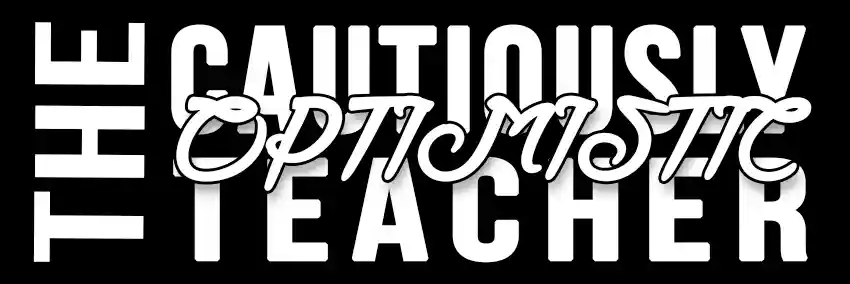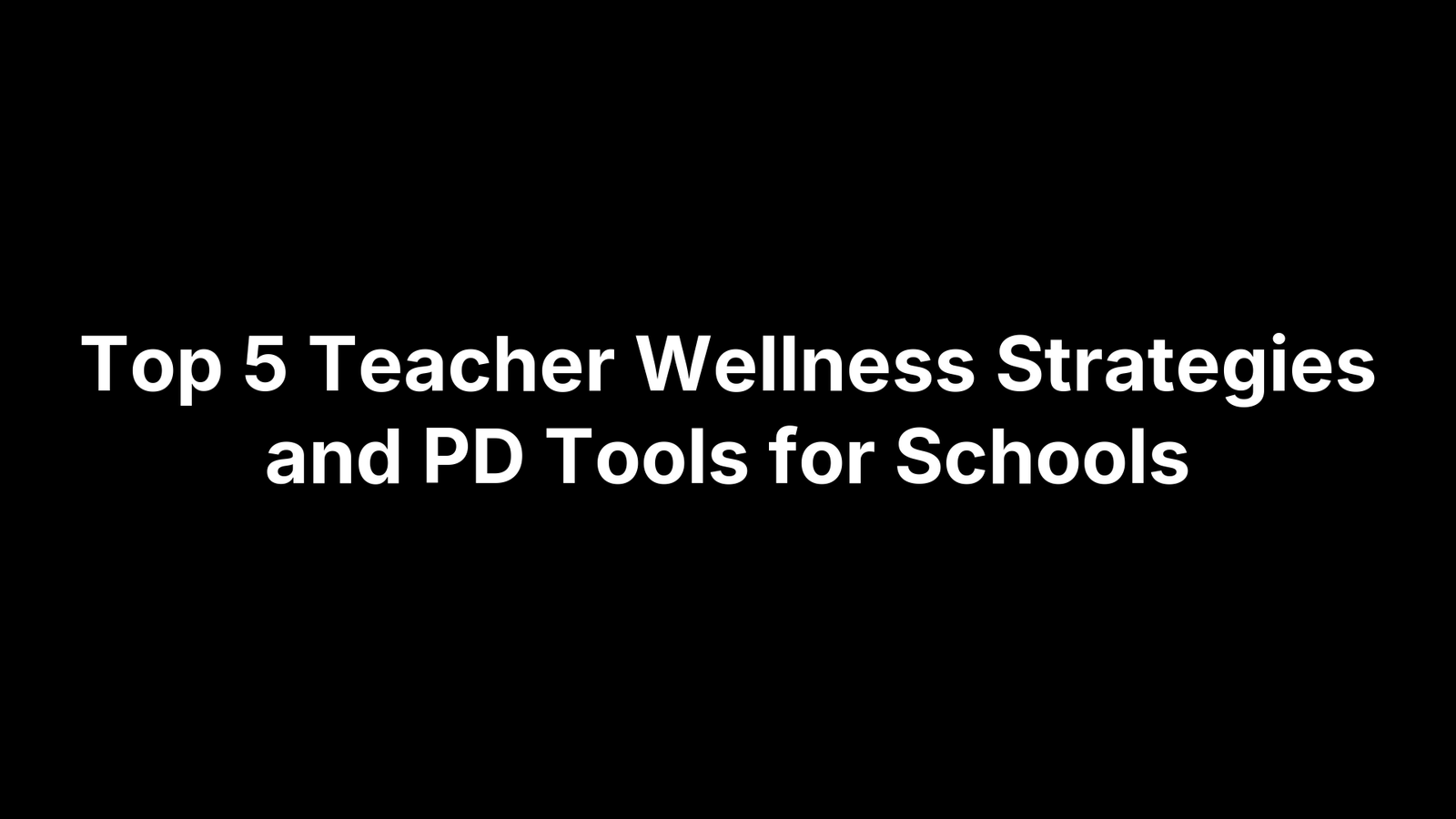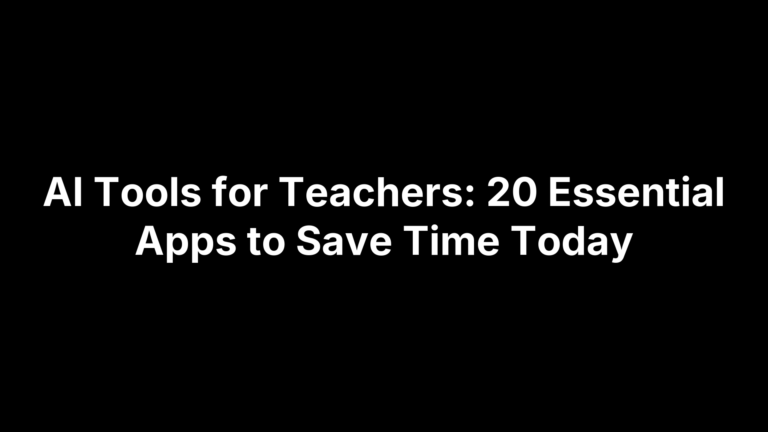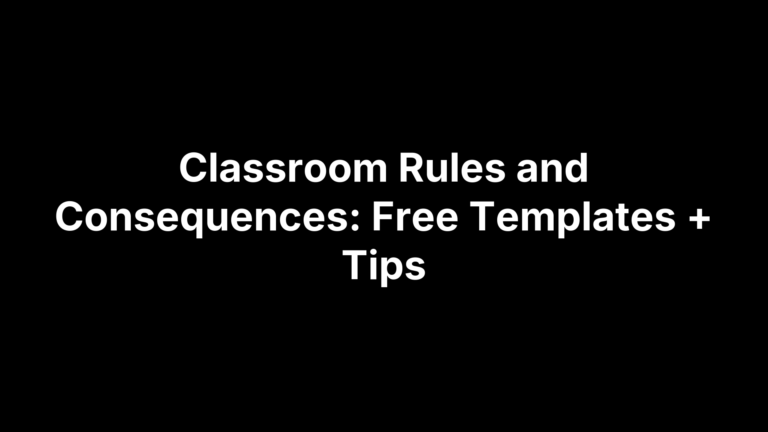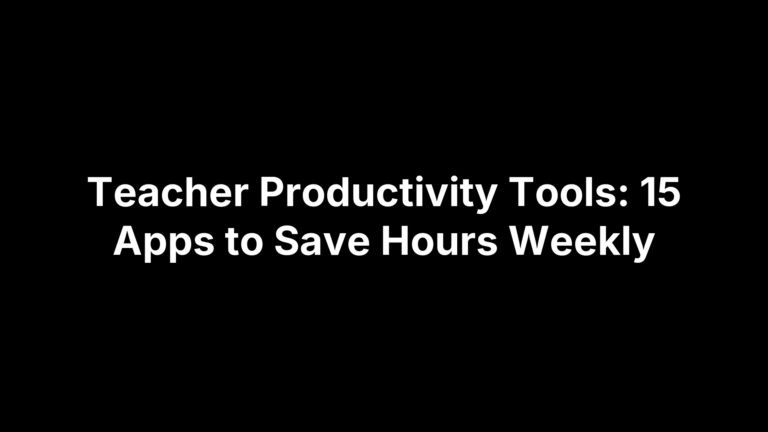Top 5 Teacher Wellness Strategies and PD Tools for Schools
If you’re a teacher or school leader, you don’t need another pep talk about self-care—you need fewer plates spinning. Between late-night grading, nonstop messages, and the emotional work of supporting students, the job can quietly expand into every corner of the day. Wellness isn’t a scented candle or a Friday jeans pass; it’s the result of better systems: smarter planning, humane grading, clear communication boundaries, and real support for adults’ social-emotional needs. When the grown-ups are resourced and rested, classrooms run better and students learn more.
This article distills five high-impact, research-informed moves that schools can implement without adding to anyone’s to-do list. You’ll find practical strategies and PD tools to: reclaim hours with AI-assisted planning and feedback; streamline grading so it actually improves learning while reducing workload; set healthy communication norms with a right-to-disconnect policy; use teacher wellness surveys to drive schoolwide action; and invest in adult SEL, mindfulness, and trauma-informed supports. For each strategy, we’ll cover why it works, what it looks like in practice, the PD resources to use, and concrete implementation steps with success metrics—so you can start, measure progress, and sustain it. Ready to make teacher wellness a built-in feature of your school, not an afterthought? Let’s get specific.
1. Save hours each week with AI planning and feedback tools (The Cautiously Optimistic Teacher)
The fastest way to boost teacher wellness is to give time back. Replacing blank‑page planning and repetitive feedback cycles with assistive tools trims low‑value tasks, reduces decision fatigue, and preserves energy for actual teaching. When schools intentionally free planning time, educators report feeling more effective and less burned out—an emphasis echoed by Edutopia’s focus on creating time for planning and breaks.
Why this supports teacher wellness
Teacher wellness influences school culture and instruction, and burnout has climbed over the past decade. Offloading routine tasks to AI reduces workload spikes, shortens after‑hours labor, and lowers cognitive load. Instead of “doing more,” teachers do the right work—designing meaningful learning and building relationships—while tech handles drafts, options, and first passes.
What it looks like in practice
Start by swapping time‑consuming planning and feedback tasks with targeted AI assists, then personalize the outputs so your voice still leads instruction and communication. Keep a shared bank of high‑quality prompts so the whole team benefits from each improvement.
- Worksheet Maker: Generate standards‑aligned exit tickets and practice sets in minutes, then tweak for your class.
- Question Generator: Create mixed‑difficulty checks for understanding and discussion stems that hit your targets.
- Differentiated Instruction Helper: Produce leveled texts, scaffolds, and extension tasks to support diverse learners.
- Report Card Commentor: Draft strengths‑based, specific comments quickly, then refine with your evidence.
PD tools and resources to use
Use The Cautiously Optimistic Teacher’s AI tools as the core “PD lab,” paired with brief, job‑embedded practice: five‑minute demos in PLCs, prompt recipe cards, and a shared template folder. Coach prompt hygiene (clear role, constraints, examples) and require human review for accuracy, equity, and tone.
Implementation steps and success metrics
Run a short pilot, measure time saved, and iterate on prompts together. Protect boundaries by setting when AI work happens during the school day, not at night.
- Baseline a two‑week time audit for planning and feedback.
- Pilot two tools for three weeks with weekly 15‑minute huddles.
- Set guardrails: privacy, no PII, always human‑edited outputs.
- Scale with a shared prompt/template library.
- Track: hours saved per week; turnaround time on feedback; teacher self‑efficacy and workload items on wellness surveys; student work quality.
Prep time saved = baseline weekly minutes − post‑implementation minutes
2. Redesign grading and feedback to reduce workload
If grading is eating your evenings, you’re not alone. Edutopia reports that excessive grading stresses out kids and teachers, stifles innovative teaching, and often fails as a true measure of learning. Pruning what you grade—and how you give feedback—reclaims time, protects teacher wellness, and keeps the focus on learning instead of point-chasing.
Why this supports teacher wellness
Heavy grading expands into nights and weekends, driving stress and burnout. Grading less frequently and more purposefully cuts low-impact tasks and creates space for planning, collaboration, and rest. When feedback is faster and more focused, teachers see stronger instruction during the day and fewer after-hours marathons—key ingredients of sustainable teacher wellness.
What it looks like in practice
Start with clarity: not every task needs a grade. Use ungraded formative checks to steer instruction and reserve grading for demonstrations of learning. Then streamline how feedback is delivered so it’s timely and doable.
- Fewer, better summatives: Cap graded tasks per unit and align tightly to priority standards.
- Feedback first, grades second: Return brief, specific feedback; release the score later or on request.
- Batch feedback: Identify 2–3 classwide trends and share whole‑class notes plus 1–2 targeted comments.
- Student ownership: Build in self‑assessment and structured peer review before anything hits your pile.
PD tools and resources to use
Anchor a short PD cycle on the “grade less, learn more” mindset highlighted by Edutopia. Share sample comment banks, whole‑class feedback templates, and single‑point rubrics. Use The Cautiously Optimistic Teacher’s Question Generator for quick, low‑stakes checks and the Report Card Commentor to speed end‑of‑term narratives while keeping them strengths‑based.
Implementation steps and success metrics
Pilot in one unit, then scale. Co-create grading calendars in PLCs to prevent overlap and protect turnaround times. Communicate norms with students and families so expectations are clear.
- Audit one unit: list all tasks; mark which truly require a grade.
- Set caps (e.g., 2–3 summatives) and adopt a feedback-first protocol.
- Create a shared comment bank and whole‑class feedback template.
- Review results in PLCs; refine and expand.
- Track: graded items per unit; average feedback turnaround; after‑hours minutes logged; student revision rates; wellness survey items on workload.
Graded items reduction (%) = (baseline − current) ÷ baseline × 100
3. Set healthy communication norms and a right-to-disconnect policy
Ping-ponging between emails, texts, and LMS messages after hours erodes recovery time and fuels burnout. As Edutopia argues, technology has pushed personal time toward extinction—reclaiming it is a systems issue, not a willpower test. Clear, shared norms plus a right-to-disconnect policy restore boundaries and protect teacher wellness.
Why this supports teacher wellness
Constant availability creates hidden overtime and stress. Establishing communication windows, delays, and escalation paths reduces decision fatigue and after-hours interruptions. When schools own the boundary-setting, teachers can rest without guilt—an essential ingredient of sustainable teacher wellness and stronger instruction the next day.
What it looks like in practice
Set simple, schoolwide rules that remove ambiguity and make exceptions explicit. Model the norms from the top so staff feel safe honoring them.
- Quiet hours: No routine messages 5:00 p.m.–7:00 a.m.; use “schedule send.”
- Response-time tiers: 24 school hours for email; 48 for non-urgent family inquiries.
- Escalation only: Emergencies route by phone to on-call admin, not teachers.
- Channel clarity: One official platform; no parallel threads on personal devices.
PD tools and resources to use
Run a 30-minute micro-PD on boundary-setting, with templates and tech tips. Share scripts and quick wins teachers can use immediately.
- Template pack: Out-of-office, family-facing norms, syllabus blurb.
- Tool settings: Scheduled send, do-not-disturb, muted notifications in the LMS.
- Leader modeling: Principals schedule messages; celebrate boundary wins in staff notes.
Implementation steps and success metrics
Co-create the norms with staff, publish them to families, and review quarterly. Audit leader behavior first.
- Draft norms with a teacher committee; union consult if applicable.
- Configure tech defaults (scheduled send on, DND guidance).
- Launch with family FAQs and classroom syllabus language.
- Monitor and reinforce in PLCs and leader check-ins.
- Track: after-hours messages per educator; average response latency; wellness survey items on workload and work-life balance.
After-hours msgs/week = total msgs 5p–7a ÷ staff countPolicy adherence (%) = compliant msgs ÷ total msgs × 100
4. Use teacher wellness surveys to drive schoolwide action
Listening is a wellness intervention. Short, research‑backed surveys elevate educator voice, pinpoint stressors, and turn “we’re overwhelmed” into a concrete plan. When leaders share results quickly and act visibly, trust grows—and so does teacher wellness.
Why this supports teacher wellness
Teacher well‑being is linked to higher teacher efficacy and better classroom dynamics, according to education research summaries (including IES/REL). Edutopia emphasizes that schools—not individual teachers—must adjust conditions to reduce stress and burnout. Surveys surface those conditions (workload, belonging, support) so leaders can target fixes that sustain teacher wellness and job satisfaction.
What it looks like in practice
Run brief, predictable pulses and close the loop within two weeks. Make the data useful at the classroom, team, and leadership levels.
- Quarterly pulses: 8–12 items plus an open comment.
- Core topics: Belonging, well‑being, self‑efficacy, staff–leadership relationships.
- Fast transparency: One‑page “You said, we did” summary to staff.
- Action in PLCs: Use results to set one PD target and one system change.
PD tools and resources to use
Use a validated Teacher Well‑Being Survey (e.g., Panorama’s research‑backed instrument) and a simple analytics dashboard that links data to strategies. Pair with IES/REL guidance on teacher wellbeing and Edutopia articles to spark staff discussions.
- Survey topics to include: Belonging; Well‑Being; Teacher Self‑Efficacy; Staff–Leadership Relationships.
Implementation steps and success metrics
Co‑design with teachers, communicate anonymity, and tie every insight to an owner and deadline.
- Build a cross‑role design team (teachers, admin, counselor).
- Select validated items and set a quarterly cadence.
- Launch, share results within 10 school days, and name 2–3 actions.
- Track progress publicly; revisit each PLC cycle.
- Track: response rate; changes on top drivers (e.g., Belonging); action completion rate; shifts in after‑hours workload items.
Response rate = responses ÷ invited × 100Belonging Δ = current mean − baseline meanAction completion (%) = completed actions ÷ planned actions × 100
5. Invest in adult SEL, mindfulness, and trauma-informed supports
Teaching is emotional labor, and when students carry trauma, teachers often absorb it too—Edutopia notes that “when students are traumatized, teachers are too.” Adult SEL and mindfulness practices lower stress reactivity, support regulation, and build collective efficacy. Done schoolwide, these supports become a protective factor for teacher wellness, not another add-on.
Why this supports teacher wellness
Mindfulness, brief recovery breaks, and trauma-informed norms help educators de-escalate, reset, and return to instruction with clarity. Schools that normalize adult SEL signal that well-being is part of the job, aligning with research and field guidance that educator well-being underpins classroom climate and instructional quality.
What it looks like in practice
Embed short, predictable recovery moments and trauma-sensitive routines into the school day. Borrow simple moves Edutopia features—like texting a colleague to cover for a one-minute reset—and make them a norm, not a favor.
- 2–3 minute breathing or grounding at meeting openers
- Peer “tap-out” coverage system during high-stress moments
- Weekly circle or check-in to process and plan supports
PD tools and resources to use
Center PD on practical skills: noticing cues, co-regulation, and restorative micro-practices. Use mindfulness resource packs, trauma-informed strategy guides, and brief videos to model routines teachers can use tomorrow.
- Mindfulness activities and Self-Care Practice Guides for adults
- Trauma-informed primers and staff-facing discussion protocols
Implementation steps and success metrics
Start with an opt-in cohort, then scale. Protect time by baking a 10-minute wellness block into existing meetings and posting step-by-step playbooks in PLCs.
- Launch a 6-week micro-PD series with classroom try-its
- Set coverage norms (who/when/how) and post in every room
- Track with pulses: stress, belonging, and usable strategies
Usage rate = tap-outs logged ÷ staff ÷ weekStress Δ = current mean − baseline mean
Bringing it all together
Teacher wellness improves when systems, not willpower, carry the load. The five moves here—give time back with AI, grade less but better, codify a right to disconnect, listen with pulse surveys, and embed adult SEL—work because they reduce friction and build shared norms. Start small, measure what matters (time saved, after-hours messages, belonging, stress), and iterate in the open so wins become culture, not one-offs.
If you’re ready to pilot, pick one lever and run a three‑week cycle with a small team, then scale. For templates, prompt cards, mini‑PD agendas, and classroom‑ready tools, explore The Cautiously Optimistic Teacher. You’ll find practical resources to help you launch quickly, track progress, and keep teacher wellness a built‑in feature of your school—so students and staff can thrive together.
